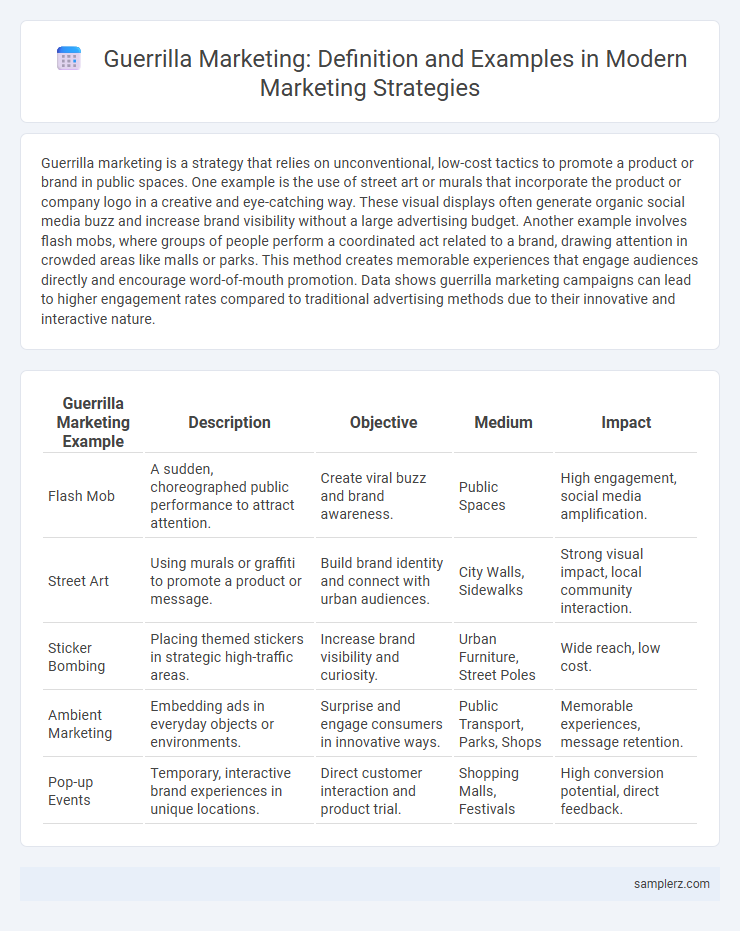Guerrilla marketing is a strategy that relies on unconventional, low-cost tactics to promote a product or brand in public spaces. One example is the use of street art or murals that incorporate the product or company logo in a creative and eye-catching way. These visual displays often generate organic social media buzz and increase brand visibility without a large advertising budget. Another example involves flash mobs, where groups of people perform a coordinated act related to a brand, drawing attention in crowded areas like malls or parks. This method creates memorable experiences that engage audiences directly and encourage word-of-mouth promotion. Data shows guerrilla marketing campaigns can lead to higher engagement rates compared to traditional advertising methods due to their innovative and interactive nature.
Table of Comparison
| Guerrilla Marketing Example | Description | Objective | Medium | Impact |
|---|---|---|---|---|
| Flash Mob | A sudden, choreographed public performance to attract attention. | Create viral buzz and brand awareness. | Public Spaces | High engagement, social media amplification. |
| Street Art | Using murals or graffiti to promote a product or message. | Build brand identity and connect with urban audiences. | City Walls, Sidewalks | Strong visual impact, local community interaction. |
| Sticker Bombing | Placing themed stickers in strategic high-traffic areas. | Increase brand visibility and curiosity. | Urban Furniture, Street Poles | Wide reach, low cost. |
| Ambient Marketing | Embedding ads in everyday objects or environments. | Surprise and engage consumers in innovative ways. | Public Transport, Parks, Shops | Memorable experiences, message retention. |
| Pop-up Events | Temporary, interactive brand experiences in unique locations. | Direct customer interaction and product trial. | Shopping Malls, Festivals | High conversion potential, direct feedback. |
Understanding Guerrilla Marketing: Definition and Core Principles
Guerrilla marketing leverages unconventional, low-cost tactics to create high impact and memorable brand experiences, emphasizing creativity and surprise over large budgets. Core principles include engaging directly with the target audience in unexpected places, fostering emotional connections, and generating word-of-mouth buzz. Examples such as flash mobs, street art, and viral social media challenges demonstrate how guerrilla marketing can disrupt traditional advertising and maximize return on investment.
Unconventional Street Campaigns That Captivate Audiences
Unconventional street campaigns in guerrilla marketing leverage unexpected urban spaces to create memorable brand experiences, such as 3D sidewalk art that visually pops and engages passersby. Brands like Coca-Cola have utilized interactive murals and pop-up installations in high-traffic areas, driving social media buzz and organic reach. These campaigns capitalize on surprise and creativity, turning everyday cityscapes into immersive advertising platforms that foster deeper audience connection.
Viral Public Stunts: Turning Heads and Earning Media
Viral public stunts in guerrilla marketing create memorable experiences that capture the audience's attention and generate extensive media coverage. These stunts often rely on creativity and surprise, leveraging social media platforms to amplify their reach and engagement. Brands like Red Bull and Coca-Cola have successfully used public stunts to spark conversations and boost brand visibility worldwide.
Experiential Marketing: Immersive Consumer Brand Encounters
Experiential marketing leverages immersive consumer brand encounters to create memorable and engaging experiences that drive brand loyalty and advocacy. Examples include pop-up shops, interactive installations, and live events where consumers actively participate, fostering emotional connections with the brand. These guerrilla marketing tactics amplify word-of-mouth and social media buzz, enhancing brand visibility and consumer engagement.
Ambush Marketing: Clever Tactics to Hijack Big Events
Ambush marketing strategically leverages major events without official sponsorship, using tactics like covert advertising and surprise appearances to capture audience attention. Brands create memorable experiences by subtly integrating their messaging into event environments, maximizing exposure while minimizing costs. This guerrilla marketing approach disrupts traditional advertising channels and enhances brand visibility through unexpected, high-impact engagements.
Flash Mobs and Pop-Up Installations: Creating Memorable Moments
Flash mobs and pop-up installations in guerrilla marketing generate buzz by surprising audiences with unexpected, engaging experiences in high-traffic locations. These tactics leverage creativity and social interaction to foster strong brand recall and viral sharing on social media platforms. Brands like T-Mobile and Coca-Cola have successfully used flash mobs and pop-up events to create memorable moments that drive consumer engagement and enhance brand visibility.
Social Media Guerrilla Tactics: Amplifying Buzz Online
Social media guerrilla marketing leverages unconventional strategies such as viral challenges, user-generated content campaigns, and surprise influencer collaborations to create organic buzz. Brands employ interactive hashtags and real-time engagement to ignite conversations and foster community participation without massive advertising budgets. These tactics maximize visibility and brand loyalty by tapping into authentic peer-to-peer networks and trending digital behaviors.
Graffiti and Creative Outdoor Advertising Examples
Graffiti as a guerrilla marketing tactic captures attention through vibrant, unexpected street art that transforms public spaces into immersive brand experiences, often generating viral social media buzz. Creative outdoor advertising employs unconventional placements and innovative designs, such as interactive billboards or 3D installations, to engage audiences uniquely and increase brand recall. Both strategies leverage urban environments to create memorable, low-cost campaigns that disrupt traditional advertising norms.
Influencer Collaboration in Guerrilla Marketing
Influencer collaboration in guerrilla marketing leverages the authentic connection influencers have with niche audiences to create viral and memorable campaigns on a limited budget. By engaging micro-influencers with highly engaged followers, brands achieve targeted reach and heightened brand awareness without traditional advertisement costs. Successful examples include street art projects or flash mob events promoted and amplified through influencer channels, generating organic buzz and user-generated content.
Measuring the Impact and ROI of Guerrilla Marketing Campaigns
Measuring the impact and ROI of guerrilla marketing campaigns requires analyzing key performance indicators such as audience engagement, social media mentions, and conversion rates. Tracking viral reach and local foot traffic using unique promo codes or QR codes provides quantifiable data to evaluate effectiveness. Post-campaign surveys and sentiment analysis further optimize future guerrilla strategies by capturing consumer feedback and brand perception shifts.

example of guerrilla in marketing Infographic
 samplerz.com
samplerz.com